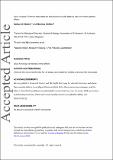Files in this item
Social runaway : fisherian elaboration (or reduction) of socially selected traits via indirect genetic effects
Item metadata
| dc.contributor.author | Bailey, Nathan W. | |
| dc.contributor.author | Kölliker, Mathias | |
| dc.date.accessioned | 2020-07-16T23:35:29Z | |
| dc.date.available | 2020-07-16T23:35:29Z | |
| dc.date.issued | 2019-07-17 | |
| dc.identifier | 260282864 | |
| dc.identifier | 2efc5e68-c56c-419b-8208-8da15fe84512 | |
| dc.identifier | 000476337500001 | |
| dc.identifier | 85069873393 | |
| dc.identifier.citation | Bailey , N W & Kölliker , M 2019 , ' Social runaway : fisherian elaboration (or reduction) of socially selected traits via indirect genetic effects ' , Evolution , vol. Early View . https://doi.org/10.1111/evo.13791 | en |
| dc.identifier.issn | 0014-3820 | |
| dc.identifier.other | RIS: urn:746508305479849E90083D852162D379 | |
| dc.identifier.other | ORCID: /0000-0003-3531-7756/work/60888421 | |
| dc.identifier.uri | https://hdl.handle.net/10023/20276 | |
| dc.description | NWB was funded by fellowships from the UK Natural Environment Research Council [NE/G014906/1 and NE/L011255/1]. | en |
| dc.description.abstract | Our understanding of the evolutionary stability of socially‐selected traits is dominated by sexual selection models originating with R. A. Fisher, in which genetic covariance arising through assortative mating can trigger exponential, runaway trait evolution. To examine whether non‐reproductive, socially‐selected traits experience similar dynamics—social runaway—when assortative mating does not automatically generate a covariance, we modelled the evolution of socially‐selected badge and donation phenotypes incorporating indirect genetic effects (IGEs) arising from the social environment. We establish a social runaway criterion based on the interaction coefficient, ψ, which describes social effects on badge and donation traits. Our models make several predictions. (1) IGEs can drive the original evolution of altruistic interactions that depend on receiver badges. (2) Donation traits are more likely to be susceptible to IGEs than badge traits. (3) Runaway dynamics in non‐sexual, social contexts can occur in the absence of a genetic covariance. (4) Traits elaborated by social runaway are more likely to involve reciprocal, but non‐symmetrical, social plasticity. Models incorporating plasticity to the social environment via IGEs illustrate conditions favouring social runaway, describe a mechanism underlying the origins of costly traits such as altruism, and support a fundamental role for phenotypic plasticity in rapid social evolution. | |
| dc.format.extent | 15 | |
| dc.format.extent | 1360579 | |
| dc.language.iso | eng | |
| dc.relation.ispartof | Evolution | en |
| dc.subject | Altruism | en |
| dc.subject | Fisher process | en |
| dc.subject | Parental investment | en |
| dc.subject | Phenotypic plasticity | en |
| dc.subject | Runaway | en |
| dc.subject | Social selection | en |
| dc.subject | QH301 Biology | en |
| dc.subject | QH426 Genetics | en |
| dc.subject | T-DAS | en |
| dc.subject.lcc | QH301 | en |
| dc.subject.lcc | QH426 | en |
| dc.title | Social runaway : fisherian elaboration (or reduction) of socially selected traits via indirect genetic effects | en |
| dc.type | Journal article | en |
| dc.contributor.sponsor | NERC | en |
| dc.contributor.sponsor | NERC | en |
| dc.contributor.institution | University of St Andrews. School of Biology | en |
| dc.contributor.institution | University of St Andrews. Centre for Biological Diversity | en |
| dc.identifier.doi | 10.1111/evo.13791 | |
| dc.description.status | Peer reviewed | en |
| dc.date.embargoedUntil | 2020-07-17 | |
| dc.identifier.grantnumber | NE/G014906/1 | en |
| dc.identifier.grantnumber | NE/L011255/1 | en |
This item appears in the following Collection(s)
Items in the St Andrews Research Repository are protected by copyright, with all rights reserved, unless otherwise indicated.

